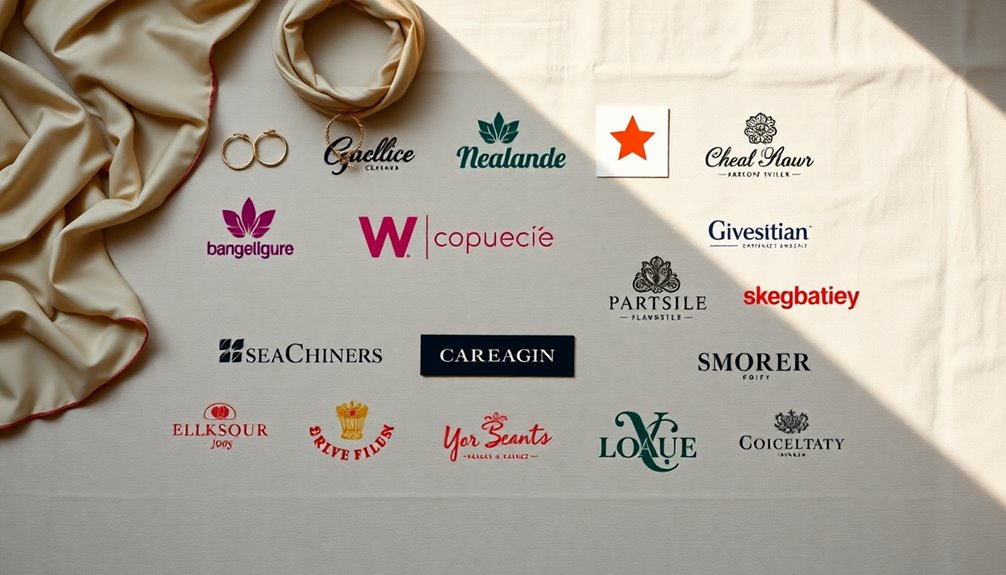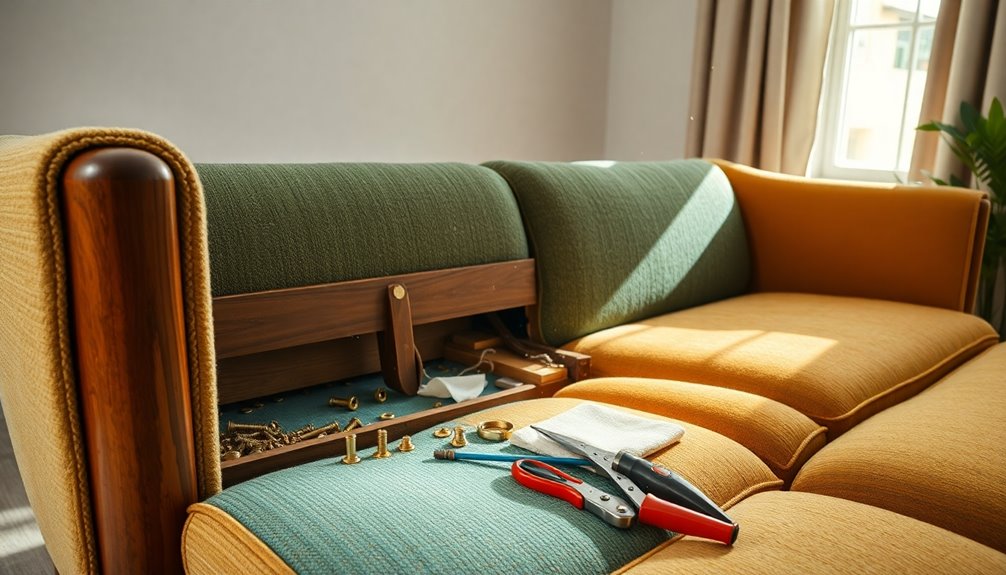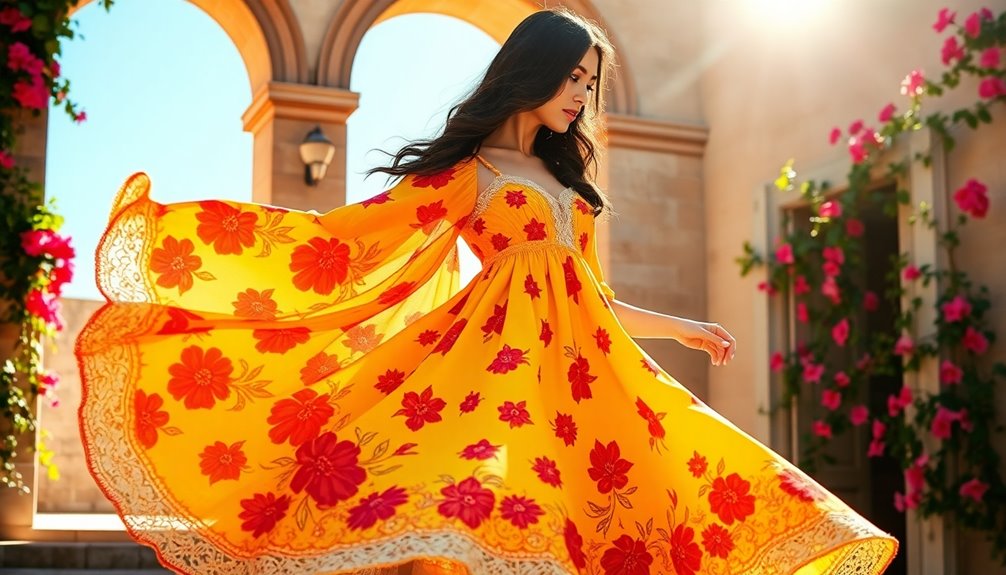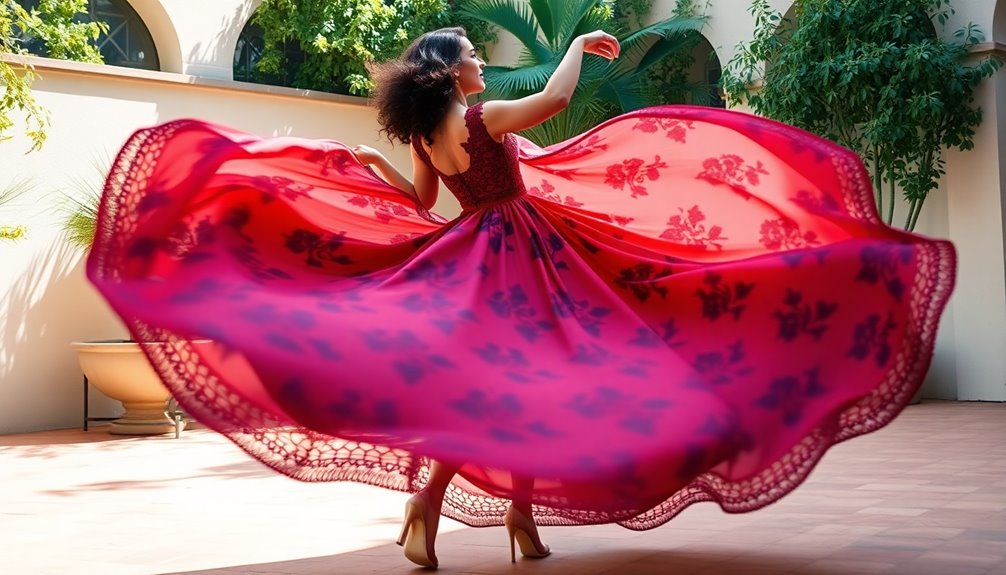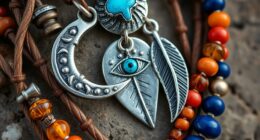Women's clothing brand logos play a crucial role in defining identity through design. They reflect cultural movements and individual styles, sending powerful messages about empowerment and self-expression. Think of how the soft colors and flowing elements often evoke femininity or how bold typography asserts confidence. As trends evolve, these logos adapt, showcasing a brand's values and mission. When you connect with a logo, it's more than just a design; it's a symbol of belonging and aspiration. Explore how these elements intertwine in fashion and see what makes each logo uniquely impactful.
Key Takeaways
- Women's clothing brand logos reflect cultural evolution, showcasing trends from flapper dresses to power dressing that resonate with societal changes.
- Iconic designers like Coco Chanel and Yves Saint Laurent have influenced logo aesthetics, merging elegance with bold representation of femininity.
- Signature logo styles utilize soft colors and flowing elements, evoking emotional connections and aligning with the brand's mission and values.
- The use of monogram logos among luxury brands conveys personalized identity, enhancing brand recognition and consumer loyalty.
- Sustainable fashion brands incorporate eco-friendly elements in their logos, reflecting a commitment to ethical practices and appealing to socially responsible consumers.
Origin and historical background of the fashion trend/style
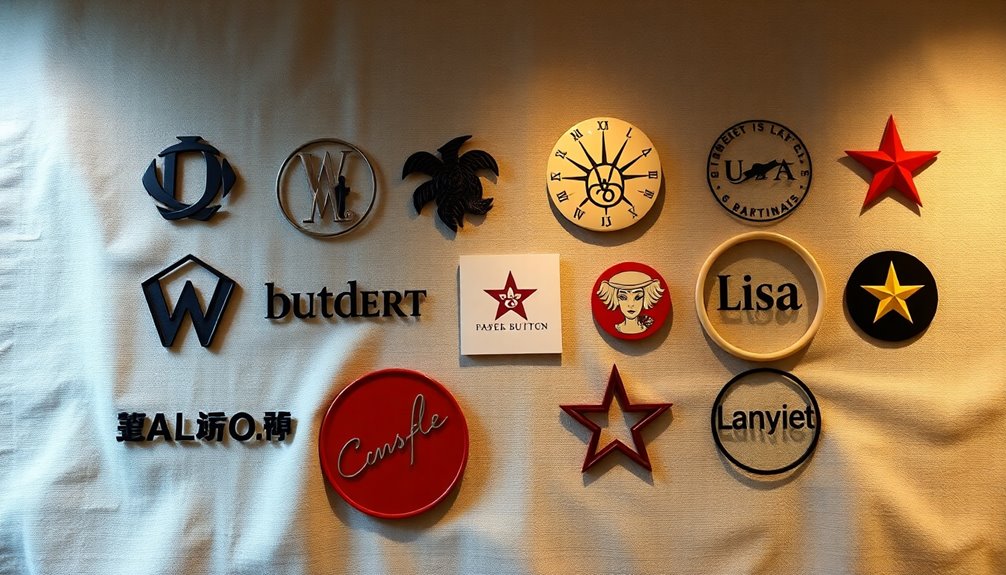
The journey of women's clothing brand logos reflects a significant transformation in fashion.
From the iconic designs of early 20th-century houses to the minimalist aesthetics of today, each logo tells a story shaped by influential designers and cultural movements.
Understanding these origins helps you appreciate the power and meaning behind the logos you see on your favorite brands.
Fashion's Transformative Journey
How did women's clothing evolve to reflect societal changes throughout history? The journey of women's fashion is a mirror of societal shifts.
In the 1920s, flapper dresses emerged, symbolizing women's liberation and the changing roles they embraced. Fast forward to the 1960s, the miniskirt revolutionized fashion, embodying youthful rebellion and sexual liberation. The feminist movement in the 1970s introduced more practical clothing, emphasizing comfort while maintaining style.
As you entered the 1980s, power dressing took center stage, with tailored suits and bold silhouettes designed to project authority and confidence in the workplace. This reflected women's growing presence in corporate environments, shaping a new brand identity for fashion brands.
By the 1990s and early 2000s, you witnessed a blend of diverse influences, from grunge to hip-hop, allowing women to express their individuality through eclectic and often unisex clothing choices.
Each of these milestones not only transformed how women dressed but also influenced the logos and branding of fashion brands, as they sought to align their identity with the evolving narratives of women's empowerment and expression.
Fashion Icons and Designers
As fashion evolved, influential designers and icons emerged, shaping women's clothing in profound ways. Coco Chanel popularized the "Little Black Dress" in the 1920s, creating a versatile piece that epitomized modern femininity and strong brand identity. This wardrobe staple revolutionized how women dressed, setting a timeless standard.
In 1947, Christian Dior introduced the "New Look," reinvigorating Paris as a fashion capital by emphasizing cinched waists and full skirts, which highlighted feminine silhouettes after World War II.
The 1960s saw Yves Saint Laurent challenge traditional gender norms with the tuxedo jacket for women, becoming an iconic symbol of empowerment in women's clothing.
In the 1970s, designers like Diane von Furstenberg embraced the feminist movement by popularizing the wrap dress, merging style with practicality and symbolizing women's liberation.
As we moved into the 1990s, fashion icons like Kate Moss and Naomi Campbell embodied the "heroin chic" aesthetic, influencing countless clothing brands with their minimalist and edgy styles.
These designers and icons not only defined trends but also established lasting legacies, showcasing the powerful connection between fashion and identity.
Key Characteristics
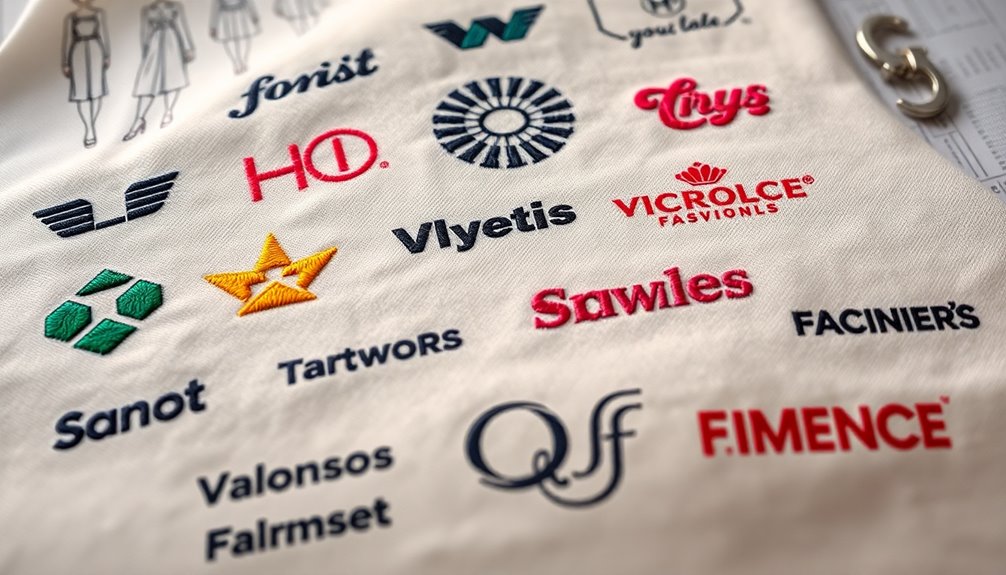
When you think about women's clothing brand logos, key characteristics like signature logo styles, sustainable fabrics and hues, and timeless wardrobe staples stand out.
These elements not only reflect the brand's identity but also resonate with your values as a consumer.
Understanding these traits can help you appreciate the thought behind the logos you encounter.
Signature Logo Styles
Signature logo styles for women's clothing brands often blend creativity and emotional resonance, showcasing unique characteristics that appeal to their target audience.
You'll notice that many logos incorporate feminine touches, using soft colors and flowing designs that enhance emotional connections. Monogram logos are particularly popular among luxury fashion brands, merging initials into sophisticated designs that offer a personalized identity.
Bold typography plays a crucial role in logo design as well. Striking fonts effectively convey brand personality and make a memorable impact on consumers.
Additionally, nature-inspired elements like floral or botanical motifs resonate with eco-conscious shoppers, reflecting the brand's commitment to sustainability.
Vintage styles also hold a special place in logo design, evoking nostalgia through retro fonts and classic color palettes. These elements attract consumers who appreciate timeless fashion and authenticity.
By understanding these signature styles, you can better appreciate how women’s clothing brands define their identities and connect with their audiences. These styles often reflect cultural influences, social movements, and individual expression. As the landscape of fashion continues to evolve, it’s important to draw parallels with other sectors, leading to an appreciation for the nuances in both women’s and men’s fashion. For those seeking to explore complementary options, consider checking out our men’s fashion brand recommendations to discover styles that resonate with modern sensibilities.
Ultimately, each logo serves as a visual representation of the brand's values and aesthetics, making it a vital component in the competitive world of women's fashion.
Sustainable Fabrics and Hues
Sustainable fabrics and hues are redefining the landscape of women's clothing, offering eco-friendly options that prioritize both style and environmental responsibility. When you choose sustainable fabrics like organic cotton, hemp, and Tencel, you support textiles produced with minimal environmental impact. These materials require less water and fewer toxic chemicals compared to traditional fabrics, making them a smart choice for the planet.
Additionally, the use of eco-friendly dyes derived from natural sources such as plants and minerals significantly reduces the release of harmful substances into waterways during the dyeing process.
As you explore brands committed to sustainable practices, you'll find they often highlight their ethical production methods, appealing to your environmentally conscious values.
Moreover, many of these brands incorporate earthy color palettes and natural hues in their designs, which resonate with consumers searching for authenticity and a connection to nature.
With the sustainable fashion market projected to grow by 9.7% from 2021 to 2028, it's clear that more people are prioritizing eco-friendly products in their wardrobes. By choosing these options, you not only enhance your style but also contribute to a more sustainable future.
Timeless Wardrobe Staples
In the realm of fashion, timeless wardrobe staples stand out for their remarkable versatility and enduring appeal. These key pieces, like the little black dress and tailored blazer, showcase classic designs that transcend seasonal trends. When you invest in women's clothing that embodies high-quality fabrics and craftsmanship, you're ensuring durability and longevity, making them worth every penny.
The beauty of these staples lies in their adaptability. You can easily style them for various occasions, whether it's a casual day out or a formal event. A neutral color palette—think black, white, beige, and navy—enhances their versatility, allowing you to mix and match effortlessly across different outfits.
Minimalist designs featuring clean lines promote simplicity and elegance, aligning perfectly with modern aesthetics. This design approach not only enhances the appeal of the pieces but also boosts brand recognition, as customers associate these iconic staples with quality and timelessness.
Modern Interpretation
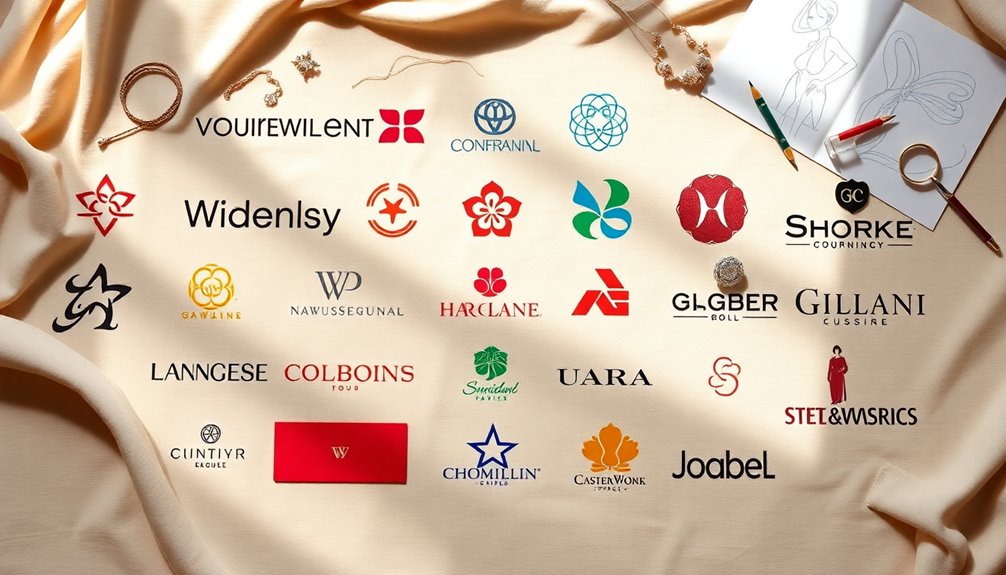
As you explore modern interpretations of women's clothing brand logos, you'll notice how sustainable fashion innovations are shaping design choices.
Renowned fashion labels are increasingly adopting eco-friendly elements, while fashion icons and trendsetters are influencing the way brands communicate their values through visuals.
This shift reflects not just aesthetics, but a deeper commitment to sustainability in the fashion industry.
Sustainable Fashion Innovations
With growing awareness of environmental issues, brands are embracing sustainable fashion innovations that prioritize eco-friendly materials and ethical production practices. You'll notice that many fashion labels now utilize organic cotton, recycled polyester, and biodegradable fabrics, significantly reducing their ecological footprint.
These sustainable fashion innovations are becoming a unique selling proposition that resonates with consumers seeking ethical clothing options.
A recent McKinsey report suggests that the global market for sustainable fashion is set to reach $8.25 billion by 2025, reflecting a shift in consumer demand. Brands are also adopting circular fashion models, designing clothing for longevity and recyclability. This encourages you, the consumer, to return used garments for refurbishment or recycling, promoting a closed-loop system.
Moreover, technology-driven solutions like digital printing and 3D knitting are revolutionizing the industry by minimizing waste and enabling on-demand production. This approach reduces overproduction and inventory waste, making fashion more sustainable.
Lastly, innovations such as blockchain for supply chain transparency empower you to make informed decisions about your clothing purchases, enhancing your role in the sustainable fashion movement. Together, these trends not only redefine fashion but also help you contribute to a healthier planet.
Renowned Fashion Labels
Throughout the fashion landscape, renowned labels like Gucci and Chanel have mastered the art of logo design, using iconic symbols and monograms to elevate their brand identity.
These fashion brands leverage their brand logos to evoke feelings of luxury and exclusivity, making a lasting impression on consumers.
On the other hand, Stella McCartney emphasizes eco-friendly practices through her logo design, appealing to environmentally conscious shoppers with innovative, sustainable aesthetics.
Minimalist labels like COS and Everlane prioritize clean lines and basic shapes, enhancing their visual identity by aligning with modern aesthetics.
Bold typography defines brands like Balenciaga and Off-White, where striking fonts take center stage to convey each brand's unique personality.
This approach captures attention and reinforces brand recognition.
Vintage-inspired logos from brands like Free People resonate with consumers seeking nostalgia and authenticity, using retro fonts and classic color palettes to evoke a timeless feel.
Fashion Icons and Trendsetters
Fashion icons and trendsetters play a pivotal role in shaping the landscape of women's clothing, influencing not just styles but also brand identities through their distinctive aesthetics. Icons like Coco Chanel and Audrey Hepburn established a legacy of elegance that resonates in logo designs today, emphasizing simplicity and sophistication.
In contrast, modern trendsetters like Rihanna and Beyoncé use their platforms to promote inclusivity and empowerment, inspiring brands to adopt logos that reflect diverse cultural influences and contemporary values.
The rise of social media has enabled these fashion icons to connect directly with consumers, leading to logo designs that appeal to younger audiences seeking relatability and authenticity. Brands like Savage X Fenty and Aerie have embraced bold typography and playful illustrations in their logos, showcasing a modern interpretation of body positivity and self-expression.
Collaborations, such as Selena Gomez's partnership with Puma, further merge personal identity with brand values, resulting in unique logo designs that resonate with a broader audience.
Ultimately, the influence of fashion icons and trendsetters is pivotal in shaping brand identity, making logo design a crucial aspect of women's clothing brands today.
Styling Tips
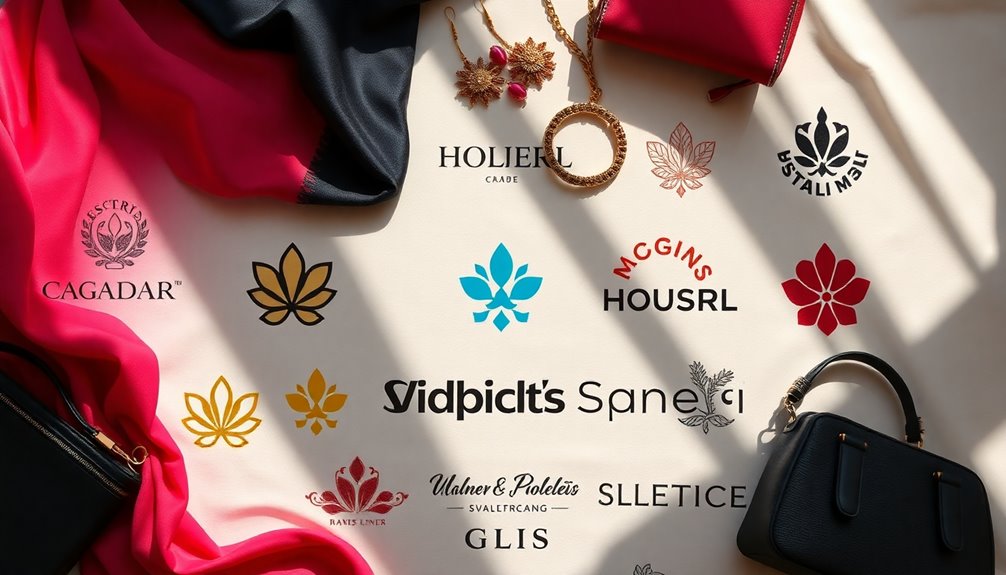
When it comes to styling your outfits, don't underestimate the power of classic closet staples that can elevate any look.
Mastering layering techniques can add versatility to your wardrobe, making it easy to transition between seasons.
Plus, experimenting with color combinations can help you create outfits that not only stand out but also reflect your personal style. Incorporating elements like glycolic acid into your skincare routine can enhance your overall appearance, making your outfits look even more polished.
Classic Closet Staples
Elevating your wardrobe starts with incorporating classic closet staples that offer versatility and timeless style. A tailored blazer is a key piece; it can effortlessly transform a casual outfit into something polished or serve you well in professional settings.
Pair it with a little black dress (LBD), the ultimate symbol of elegance; this timeless staple easily adapts for cocktail parties or formal events.
Next, a white button-down shirt is essential for creating refined looks. Whether paired with jeans for a casual vibe or tailored trousers for a business meeting, its versatility is unmatched.
High-quality, well-fitted jeans are another foundational piece in any woman's wardrobe, balancing comfort with style for both dressed-up and laid-back occasions.
Lastly, don't underestimate the power of classic pumps in neutral shades. They not only elongate your legs but also complement a wide range of outfits, embodying the essence of fashion.
Many brands design logos that reflect these core staples, establishing an identity that resonates with timeless style.
Layering Techniques for Versatility
Incorporating layering techniques into your wardrobe can enhance the versatility of your outfits, making them suitable for a variety of occasions and weather conditions.
Start by mixing textures; pairing a chunky knit sweater with a sleek silk blouse not only adds depth but also boosts visual interest. Choose lightweight, breathable fabrics to ensure comfort while transitioning from day to night without sacrificing style.
Experiment with different lengths to create flattering proportions—try a long cardigan over a shorter top to enhance your body shape. This approach adds dimension to your look while maintaining practicality.
Don't forget to accessorize! Statement belts or scarves can define your waist and introduce a pop of color or pattern, making your layered outfit more polished and stylish.
Layering techniques not only keep you warm but also allow for creative combinations that express your personal style.
With a little experimentation, you can easily adapt your outfits for work, casual outings, or evening events, showcasing your versatility and fashion sense.
Embrace the art of layering, and you'll discover endless possibilities in your wardrobe.
Color Combinations for Outfits
Understanding how to mix and match colors can transform your outfits and elevate your personal style. One effective approach is utilizing monochrome color schemes, which create a sophisticated, timeless look. This makes it easy to mix and match while maintaining a cohesive aesthetic.
Consider incorporating earthy color palettes, like greens, browns, and muted tones, that reflect current trends and resonate with eco-friendly fashion values.
If you're looking to make a statement, bold, vibrant colors can evoke strong emotions and draw attention. These are perfect for statement pieces or accessories that enhance your outfit's overall impact.
Additionally, pairing complementary colors, such as blue and orange or red and green, creates dynamic visual interest that helps your outfits stand out.
Pastel shades, like lavender or mint, can soften your overall look and add a touch of femininity, making them ideal for spring and summer collections.
As you explore color combinations, remember that the right choices can elevate even the simplest outfits. Embrace your inner fashion designer, experiment with these tips, and find the combinations that express your unique identity. Incorporating natural elements into your outfits can also enhance your overall aesthetic and promote tranquility.
Shopping Guide
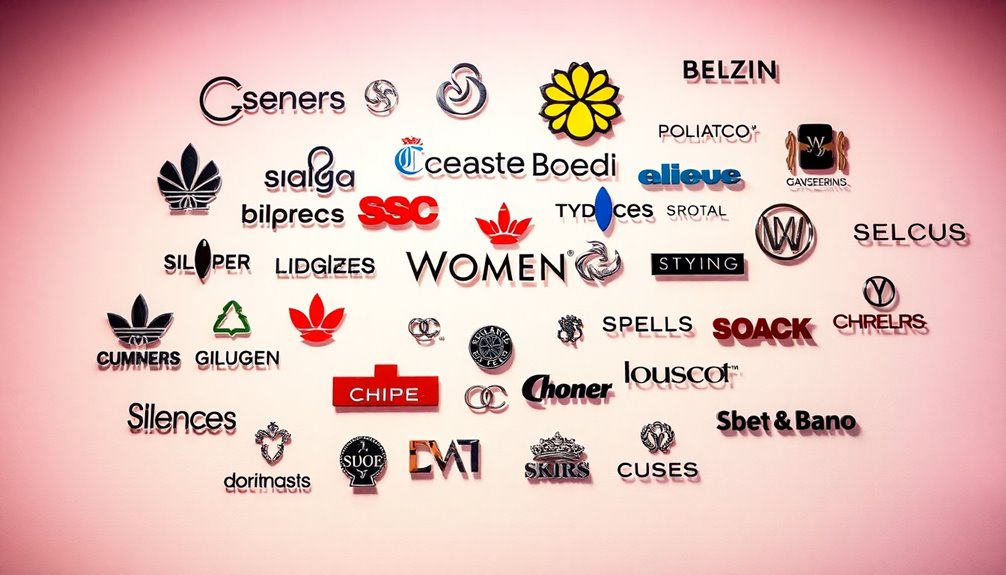
When you're shopping for women's clothing brands, keep an eye out for logos that truly capture the brand's identity. A well-designed brand logo often reflects the essence of the brand through its colors, typography, and overall design elements.
Pay attention to the brand name and how its visual identity aligns with its mission and values. Explore the brand's visual identity style guide, as it can provide insights into its target audience and help you make informed purchasing decisions.
Brands that use unique design elements, like monograms or iconic symbols, typically enhance brand recognition and convey a sense of quality and sophistication. Examine how the brand logo fits into its overall marketing strategy; strong brand identities maintain consistent logo usage across various platforms, reinforcing their message.
Additionally, look for brands that incorporate storytelling into their logo designs, creating an emotional connection that makes their products more relatable. By focusing on these aspects, you'll not only shop smarter but also deepen your appreciation for the artistry behind women's clothing brands.
Upcycling Old Clothing Pieces
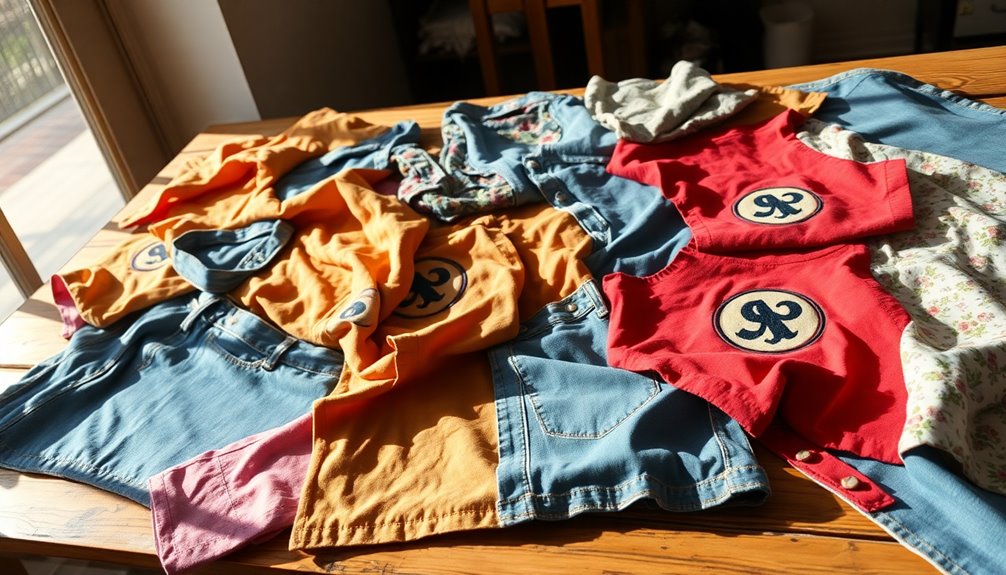
Upcycling old clothing pieces is a fantastic way to repurpose fabrics creatively and give new life to your wardrobe.
You can explore fabric painting techniques that transform worn-out items into unique fashion statements.
Repurposing Fabrics Creatively
Transforming old clothing pieces into stylish new creations can be both rewarding and environmentally friendly. By embracing upcycling, you can significantly reduce waste while contributing to sustainable practices in the fashion industry. Studies show that upcycling can lower the carbon footprint linked to clothing production, making your creative efforts even more impactful.
Get inspired by techniques like patchwork, dyeing, and embellishing. These methods let you personalize your clothing, ensuring that each piece remains unique and reflects your style. According to the Ellen MacArthur Foundation, upcycling can extend the lifecycle of garments by 5-10 years, which is a crucial step in combating the environmental issues caused by fast fashion.
Fashion labels are increasingly recognizing the potential of upcycled materials, showcasing high-quality items made from repurposed fabrics. This growing trend appeals to eco-conscious consumers who value creativity and originality in their wardrobes. Additionally, incorporating sustainable living practices can further enhance the environmental benefits of your upcycling efforts.
Plus, by engaging in DIY projects, you support local economies and promote small-scale production, creating jobs within your community. So, why not dive into the world of upcycling and express your individuality while making a positive impact on the planet?
Fabric Painting Techniques
Breathing new life into old clothing pieces can be achieved through various fabric painting techniques that allow for personalized designs. You can explore options like tie-dye, stenciling, and freehand painting to transform your wardrobe while upcycling clothing. Each method offers a unique way to express your creativity and individual style.
Using high-quality fabric paints ensures better adhesion and longevity, making your designs durable and wash-resistant. In the design process, don't hesitate to experiment with tools like paintbrushes, sponges, and fabric markers. These tools help you achieve diverse textures and effects, enhancing the visual appeal of your pieces.
To elevate your upcycled garments even further, consider incorporating elements like embroidery or fabric patches alongside your painted designs. This combination adds depth and character, making each piece truly one-of-a-kind. Additionally, exploring eco-friendly options like natural dyes can further enhance your sustainable fashion journey.
Cultural Impact
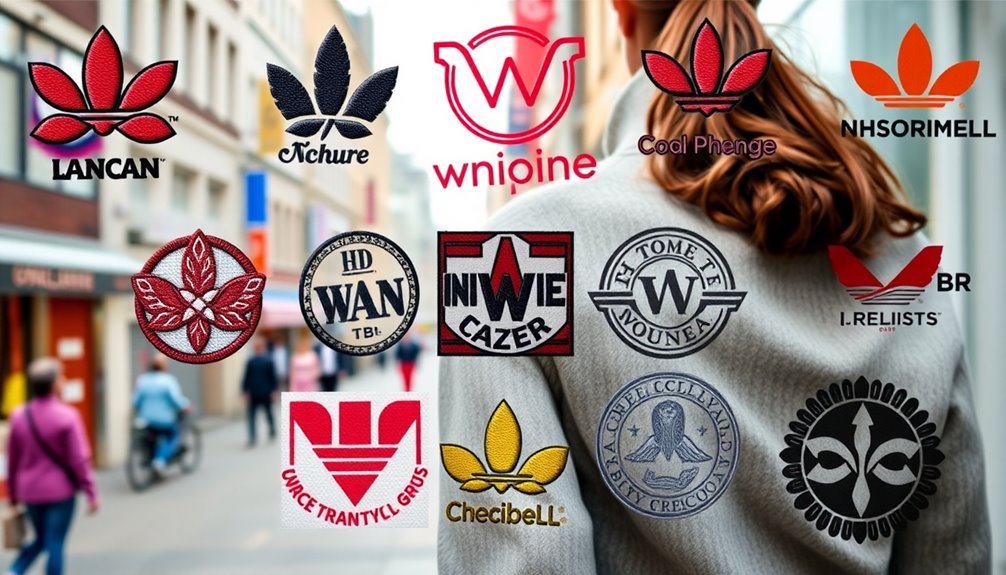
When you think about women's clothing brand logos, consider how they often intersect with fashion in film and music, shaping cultural trends.
These logos do more than just represent a brand; they can also become symbols of activism, reflecting societal values and movements.
Fashion in Film and Music
Fashion in film and music has undeniably shaped cultural narratives and influenced consumer behavior. Iconic films like "Breakfast at Tiffany's" and "The Devil Wears Prada" have set trends, making styles synonymous with the characters they portray. You might find yourself drawn to the elegance of these films, as they tell a story that resonates with your own identity.
In the music industry, artists like Beyoncé and Lady Gaga collaborate with top designers, crafting visuals that not only enhance their artistic identities but also influence your fashion choices. The 2021 Met Gala highlighted this synergy, showcasing how celebrities use fashion to express cultural narratives and elevate emerging designers.
With research indicating that 67% of consumers are influenced by celebrities from film and music, it's clear that visual media plays a powerful role in shaping your fashion decisions. The rise of social media platforms like Instagram and TikTok further amplifies this influence, allowing trends to spread rapidly and encouraging you to engage with the latest styles.
As you navigate through your wardrobe, remember how deeply intertwined fashion in film and music is with the fashion industry, impacting your choices every day. Effective public speaking can also enhance your ability to articulate your fashion preferences and connect with others who share your interests.
Fashion and Activism Intersection
In today's world, the intertwining of fashion with activism serves as a powerful platform for social change, inviting you to consider what your clothing choices say about your values. Many women's clothing brands have embraced this shift, prioritizing core values like social justice, sustainability, and inclusivity.
Over half of millennials are willing to pay more for products from socially responsible companies, showing that you're not alone in your desire for brands that reflect your identity. Companies like Reformation and Patagonia exemplify this trend, integrating activism into their business models while tackling issues such as climate change.
A 2021 survey revealed that 66% of global consumers believe brands should take a stand on social, environmental, and political issues. This alignment encourages you to choose clothing brands that resonate with your beliefs and support movements for women's rights and racial equality.
Moreover, collaborations between fashion labels and activist organizations are becoming increasingly common, raising awareness and funds for important causes. By wearing these brands, you actively participate in a cultural shift that champions diversity and representation, reinforcing your commitment to creating a more just world through your fashion choices. Additionally, seeking professional help can enhance personal growth and emotional resilience, making you more aware of the impact your fashion choices have on social issues.
Frequently Asked Questions
How to Build Clothing Brand Identity?
To build your clothing brand identity, start by crafting a clear mission statement that reflects your core values.
Next, conduct market research to pinpoint your target audience's preferences.
Design a memorable logo and visual style that captures your brand's essence, using color and typography wisely.
Ensure your packaging aligns with this identity, as it can influence buying decisions.
Finally, stay adaptable, using consumer feedback and market trends to keep your brand relevant.
How Do You Design a Brand Identity?
To design a brand identity, start by defining your core values and mission statement.
Understand your target audience to guide your visual elements.
Create a memorable logo and select a color palette and typography that reflect your brand's personality.
Develop a style guide for consistency across all materials.
Finally, gather consumer feedback regularly to adapt and ensure your brand stays relevant and resonates with your audience's preferences.
What Is the Difference Between Logo Design and Identity Design?
Logo design focuses on creating a distinct visual symbol for your brand, aiming for simplicity and memorability.
In contrast, identity design encompasses a broader range of elements, like color palettes and typography, to convey your brand's personality and values.
While a logo serves as your brand's primary identifier, identity design ensures a cohesive experience across all platforms, fostering recognition and emotional connections with your audience over time.
How to Represent Brand Identity?
To represent brand identity effectively, you need to focus on key elements that reflect your values and resonate with your audience.
Start by choosing colors and typography that align with your brand's personality. Use consistent visual elements across all platforms to enhance recognition.
Don't forget to create a style guide that outlines how to apply these elements cohesively. This way, you ensure your brand communicates a clear and memorable message to consumers.
